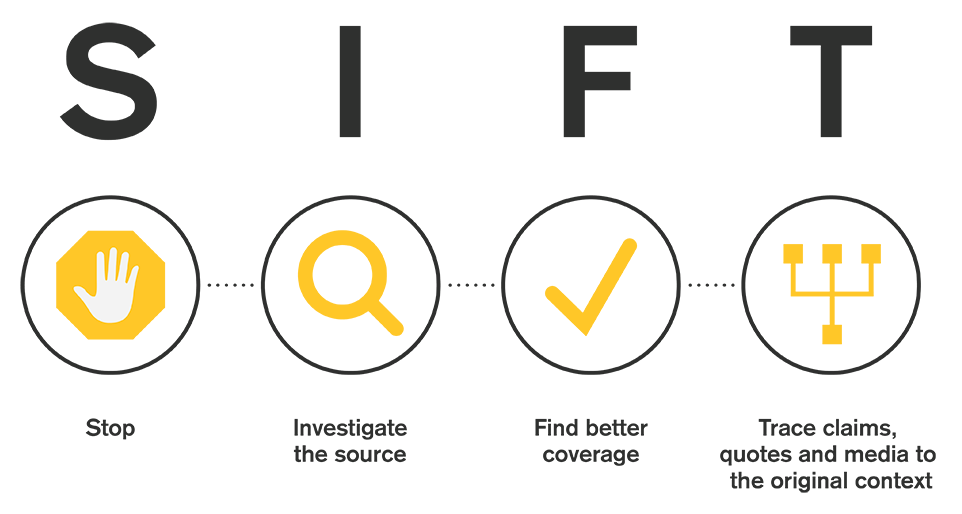Mike Caulfield, Washington State University digital literacy expert, has helpfully condensed key fact-checking strategies into a short list of four moves, or things to do to quickly make a decision about whether or not a source is worthy of your attention. It is referred to as the “SIFT” method:

Stop
![]()
When you initially encounter a source of information and start to read it—stop. Ask yourself whether you know and trust the author, publisher, publication, or website. If you don’t, use the other fact-checking moves that follow, to get a better sense of what you’re looking at. In other words, don’t read, share, or use the source in your research until you know what it is, and you can verify it is reliable.
This is a particularly important step, considering what we know about the attention economy—social media, news organizations, and other digital platforms purposely promote sensational, divisive, and outrage-inducing content that emotionally hijacks our attention in order to keep us “engaged” with their sites (clicking, liking, commenting, sharing). Stop and check your emotions before engaging!
Investigate the Source
![]()
You don’t have to do a three-hour investigation into a source before you engage with it. But if you’re reading a piece on economics, and the author is a Nobel prize-winning economist, that would be useful information. Likewise, if you’re watching a video on the many benefits of milk consumption, you would want to be aware if the video was produced by the dairy industry. This doesn’t mean the Nobel economist will always be right and that the dairy industry can’t ever be trusted. But knowing the expertise and agenda of the person who created the source is crucial to your interpretation of the information provided.
When investigating a source, fact-checkers read “laterally” across many websites, rather than digging deep (reading “vertically”) into the one source they are evaluating. That is, they don’t spend much time on the source itself, but instead they quickly get off the page and see what others have said about the source. They open up many tabs in their browser, piecing together different bits of information from across the web to get a better picture of the source they’re investigating.
Please watch the following short video [2:44] for a demonstration of this strategy. Pay particular attention to how Wikipedia can be used to quickly get useful information about publications, organizations, and authors.
Note: Turn on closed captions with the “CC” button or use the text transcript if you prefer to read.
Find Better Coverage
![]()
What if the source you find is low-quality, or you can’t determine if it is reliable or not? Perhaps you don’t really care about the source—you care about the claim that source is making. You want to know if it is true or false. You want to know if it represents a consensus viewpoint, or if it is the subject of much disagreement. A common example of this is a meme you might encounter on social media. The random person or group who posted the meme may be less important than the quote or claim the meme makes.
Your best strategy in this case might actually be to find a better source altogether, to look for other coverage that includes trusted reporting or analysis on that same claim. Rather than relying on the source that you initially found, you can trade up for a higher quality source.
The point is that you’re not wedded to using that initial source. We have the internet! You can go out and find a better source, and invest your time there. Please watch this video [4:10] that demonstrates this strategy and notes how fact-checkers build a library of trusted sources they can rely on to provide better coverage.
Note: Turn on closed captions with the “CC” button or use the text transcript if you prefer to read.
Trace Claims, Quotes, and Media to the Original Context
![]()
Much of what we find on the internet has been stripped of context. Maybe there’s a video of a fight between two people with Person A as the aggressor. But what happened before that? What was clipped out of the video and what stayed in? Maybe there’s a picture that seems real but the caption could be misleading. Maybe a claim is made about a new medical treatment based on a research finding—but you’re not certain if the cited research paper actually said that. The people who re-report these stories either get things wrong by mistake, or, in some cases, they are intentionally misleading us.
In these cases you will want to trace the claim, quote, or media back to the source, so you can see it in its original context and get a sense of whether the version you saw was accurately presented. Please watch the following video [1:33] that discusses re-reporting vs. original reporting and demonstrates a quick tip: going “upstream” to find the original reporting source.
Note: Turn on closed captions with the “CC” button or use the text transcript if you prefer to read.
Sources
“Online Verification Skills – Video 2: Investigate the Source.” YouTube, uploaded by CTRL-F, 29 June 2018.
“Online Verification Skills – Video 3: Find the Original Source.” YouTube, uploaded by CTRL-F, 25 May 2018.
“Online Verification Skills – Video 4: Look for Trusted Work.” YouTube, uploaded by CTRL-F, 25 May 2018.
SIFT text adapted from “Check, Please! Starter Course,” licensed under CC BY 4.0
SIFT text and graphics adapted from “SIFT (The Four Moves)” by Mike Caulfield, licensed under CC BY 4.0
